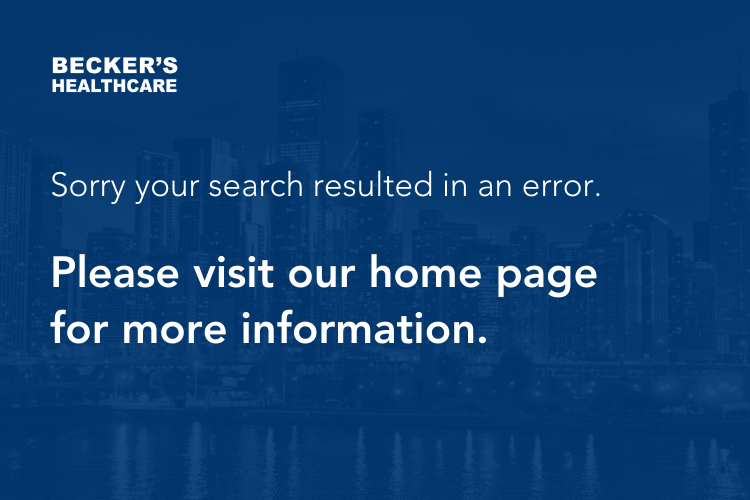Error 404 Page
Super User -
Copyright © 2024 Becker's Healthcare. All Rights Reserved. Privacy Policy. Cookie Policy. Linking and Reprinting Policy.
Featured Webinars
Featured Whitepapers
10 Most-Read Articles
- Executive compensation at HCA, CHS, Tenet and UHS: 7 things to know
- Hackers start selling Change Healthcare data
- The 100 top hospitals in 2024, per Fortune
- UnitedHealth CEO: '[It's] important for the country that we own Change Healthcare'
- Lawmakers express fury toward UnitedHealth in first Change attack hearing
- California hospital chair resigns amid alleged $23M exec overpayment
- 20 large health systems ranked by reputation score
- Alabama hospital up for auction 4 years after opening
- CHS to sell Tennessee hospital
- Private equity healthcare bankruptcies are on the rise: 8 things to know
Featured Learning Opportunities
Featured Content
- How will we solve healthcare’s most pressing challenges? Innovative technologies provide solutions
- How providers are using AI to automate administrative work and reduce burnout
- Expert Q&A: Closing the Gap in Rural Health Outcomes
- Overcoming today's economic headwinds: Executive insights from CommonSpirit Health and UChicago Medicine
- The Value of Local in a GIG Economy
- How to protect patient safety when facing drug shortages
- Five ways to help your small group clients get the most out of their health insurance plans
- Multiple Talent Strategies: The Key to Success Today and Tomorrow
- Why Care Settings Matter: LTACHs vs. SNFs
- Quality transformation: How hospitals are striking a balance between the bottom line and better care
- Healthcare Finance Trends for 2023: A Mid-Year Update
- TESS: How HHS’ Technology Enabled Support Services are Transforming Healthcare
Top 40 Articles from the Past 6 Months
- 6 hospitals seeking CEOs
- The best hospital in each state, per Newsweek
- Catholic health system to replace all crucifixes
- 22 recent hospital, health system executive moves
- California system gave $100,000 bonuses to nurses for retention. Did it work?
- 8 drugs now in shortage
- UnitedHealth suspects 'nation-state' behind Change outage: 7 things to know
- Jury ups Johns Hopkins hospital damages to $261M in Netflix case
- 22 hospitals, health systems cutting jobs
- Experts scramble to understand rising cancer rates in young adults
- Jury rules against Johns Hopkins in case made famous by Netflix
- Meet the 24-year-old running a Colorado hospital
- Former Kaiser nurse awarded $41M in retaliation lawsuit
- 150+ top places to work in healthcare | 2024
- 15 'overpaid' CEOs in healthcare
- Mark Cuban: CEOs 'waste a sh-tload of money' on healthcare
- Walmart names 1st health system partner
- 5 hospitals seeking CEOs
- 12 women making moves in healthcare
- From -6.8% to 12.2%: 43 health systems ranked by operating margins
- 12 healthcare trends and issues we are following for 2024
- Amazon launches One Medical for Prime
- As Steward's finances stumble, spotlight turns to CEO's yachts
- 100 largest hospitals and health systems in the US | 2023
- 11 recent hospital, health system CEO moves
- Hackers leak Change Healthcare contracts, patient data
- 'An attack on the entire sector': Fallout from Change Healthcare hack continues
- Best healthcare jobs in 2024: US News
- Healthgrades' 50 top hospitals for 2024
- UChicago sued for negligence in death of Silver Cross Hospital CEO
- 418 rural hospitals at risk of closure, breakdown by state
- 15 health systems with strong finances
- Ransomware group leader told hackers to attack hospitals, FBI, HHS say
- The No. 1 problem still keeping hospital CEOs up at night
- Where are Leapfrog's 18 straight-'A' hospitals?
- HHS intervenes in Change Healthcare hack
- The layoff runway lengthens
- Mark Cuban's drug company partners with 1st health system
- COO of Tennessee hospital gives resignation days after CEO
- Pennsylvania hospital CEO resigns


